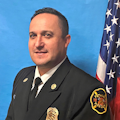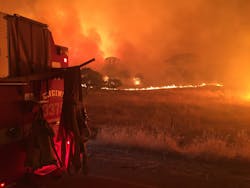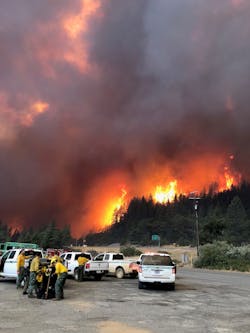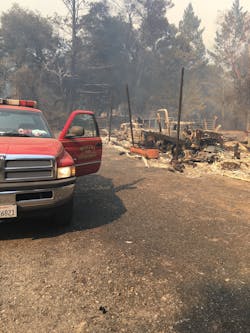On Oct. 8, 2017, the Tubbs Fire ignited and quickly grew to become the most destructive fire in California history. The fire burned 36,807 acres, destroyed 5,643 structures and killed 22 people. Conversely, in late October 2019, the Kincade Fire burned 77,758 acres, destroyed 374 structures but resulted in zero fatalities.
There are many reasons for the differences in the outcomes of these two fires, but lessons that were learned from 2017 and that were implemented two years later directly affected the outcome of the Kincade Fire.
As fire service leaders, we continue to adapt to our changing environment and to make significant progress in defending these unprecedented fires, which many of us believe is the new normal.
Tubbs Fire
In early October 2017, multiple fires ignited simultaneously throughout Sonoma, Napa and Mendocino counties. During a predicted wind event, fires quickly grew out of control. The Tubbs Fire grew rapidly. (Resources were spread thin throughout the three counties.)
The leadership of the Tubbs Fire did an amazing job. Recognition of the effect that the unprecedented wind event would have on how fast-moving and destructive that wildfire would be led leadership to determine that the fire wasn’t going to be stopped and that transition to an evacuation mode was key to saving lives.
Firefighter safety and the public’s safety were the top priorities. Saving property and using fire control tactics weren’t advised unless they would have direct successful results in saving lives of crew or civilians. This early decision to evacuate is a teaching point for all firefighters, that a change in mindset is required.
These fires grow rapidly and are driven by significant winds in an environment where the fuel models are drought-stricken. It’s imperative that leaders and supervisors prepare to recognize early that these can be a losing battle: No amount of resources is going to be able to stop these fires that are the new normal. Then, leaders must transition quickly and express their intent down through all of the ranks.
During the early stages of the Tubbs Fire, law enforcement was involved heavily with evacuations and rescues. The fire spread rapidly. Many civilians were in its path. Exit routes were minimal. The community was unprepared for evacuations. The task was daunting.
(My wife and children were caught up in the massive traffic jam as thousands of people fled our community. Luckily, as the Tubbs Fire jumped the 101 Freeway, they happened to be on an overpass, safe from the fire. To fully evacuate the fire area, it took them almost an hour, which on a normal day takes minutes.)
Turning roadways and freeways into one-way traffic and communicating a traffic plan early on is important. This process might not be possible in every situation, but evacuation plans and traffic-flow plans for your community can be extremely helpful in limiting congestion, allowing first responders access into the fire area and saving lives.Incident commanders (ICs) must clearly and accurately communicate evacuation zones and needs to law enforcement as early and as often as possible. This allows law enforcement leadership to quickly devise a traffic plan, including staffing intersections.
Multi-agency pre-incident training and planning needs to occur, so law enforcement officers and the community are proficient and aware of your needs.
Civilian knowledge of the pre-determined plan helps when law enforcement isn’t available for traffic (instead involved with evacuations and rescues).
When houses are in the path of the fire, firefighters and law enforcement officers must go door to door to ensure that everyone is out. As soon as that’s completed or additional officers arrive, law enforcement should turn their attention to the traffic plan and assist with decreasing congestion and speeding the flow of civilians out of the area.
Expanding evacuation zones early saves you from getting behind the curve. Early recognition and early evacuations allow firefighters the opportunity to transition back to normal firefighting tactics where possible, including saving property and protecting the environment. With the ferocity and rapid growth of these fires, the normal mindset on evacuation zones must change. What normally is considered an adequate area to evacuate now must be doubled. When you have it set in your mind that you established an adequate evacuation zone, go even larger.
Kincade Fire
Along with the destructive wildfires during October 2017, California was ravaged by multiple devastating fires in 2018. The Carr Fire tore through communities in and around Redding. The Mendocino Complex Fire devastated much of the Mendocino National Forest and its surrounding communities. The Camp Fire destroyed Paradise (a community that had an evacuation and traffic plan) and its surrounding communities. The Woolsey Fire burned hundreds of thousands of acres in December 2018. Taking lessons learned from all of these disasters, the California fire service continues to adapt and to implement positive changes.
On Oct. 23, 2019, the Kincade Fire ignited northeast of Geyserville. It started during an anticipated north wind event. The circumstances of this fire were different than the Tubbs Fire, the most distinct being that the Kincade was the only large fire that ignited during the wind event. Yes, firefighters could focus their efforts on one fire, but the outcome of the incident was aided greatly by the lessons that were learned from previous fires. The fire service, law enforcement and additional cooperators were much more prepared.
Although highly scrutinized in Northern California, the power safety shut-offs played a major role in the success in limiting the loss of lives.
Sonoma County had made vast improvements to its alert warning systems. During the Kincade Fire, there was an improvement in communication to the public, including fire information, evacuation areas, power and gas information, evacuation processes, and human shelter and animal shelter locations. This information flow must be a top priority of ICs and their cooperators.
The totality of this incident grew rapidly as fire and law enforcement officials recognized the potential for growth. Because of the red-flag warning, Sonoma County and CAL FIRE prepositioned wildland firefighting engines and water tenders throughout Sonoma County to be on scene as quickly as possible. This saved many homes on the first night of the fire. If not prepositioned, valuable time would have been lost in the dispatch and response phase.A CAL FIRE incident management team was ordered early and provided key assistance to the on-scene leadership. Evacuation-zone decisions that were made by initial ICs and the leadership throughout the incident directly contributed to the limited loss of structures. Early on, evacuation orders were given for a potentially large affected area, and law enforcement leadership was embedded with the ICs. This allowed for a coordinated evacuation process. (Although fire personnel assisted, most fire resources were able to re-focus on saving property and fire control.)
A couple of days into the incident, a second wind event was predicted. With the management team in place, and firefighters and law enforcement from around the state on scene or en route, a massive, unprecedented evacuation took place. Prior to the next wind event, fire and law enforcement officials made a decision to evacuate a large portion of Sonoma County. Fire models had predicted the possibility that the Kincade Fire could explode and burn all the way to the Pacific Ocean. With that possibility, the fire threatened 80,000 additional homes. The unprecedented mandatory evacuation was executed by a well-thought-out and communicated plan. Having residences evacuated from the fire area and civilians removed from the potential spread area allowed firefighters to focus on structure defense and containing the perimeter of the fire. Although the fire didn’t spread as far as predictions said that it could, being prepared and ready for the potential was a necessary decision.
After the 2017 fires, Sonoma County fire officials implemented a surge plan. A countywide system was implemented in which one single alarm would activate every fire organization’s pager system. The surge plan is referred to commonly in Sonoma County as the all call. The purpose of an all call is to notify all firefighters who are in the county that there’s a major incident and that all of the available resources should respond.
The all call could be used early in an incident or later when resources are immediately needed to save lives and property. The all call was initiated during the Kincade Fire.
Although adjustments and improvements to the plan are ongoing, the surge plan is extremely useful, and it played a role in the firefighting capabilities of resources that were assigned to the incident. It’s imperative that the surge plan is coordinated with the ICs; accountability is paramount on a wildland incident. Firefighters and resources are spread out in a large geographical area, so accountability can be difficult.
This is where the coordination of the surge plan becomes most critical. Although supervisors would welcome additional help, the infusion of unaccounted resources can spell disaster. Coordinated plans allow accountability to be achieved, which bolsters incident resources and has immense positive effects on your firefighting capabilities.
When fires are in/around communities, it’s extremely important for the management team to ensure that incident action plans are distributed to every agency in the surrounding area. Agency leadership that isn’t assigned to the fire needs to ensure that their firefighting force gets incident information and a brief on the current plan. That way, when a surge is needed, responding resources are aligned with the incident management’s mission. (During Kincade, it was comforting to know that I had multiple resources in my back pocket. It’s my belief that these surge plans should be implemented and trained upon throughout every county in California.)
Tactical patrol is one of the most important tactics during these massive wildfires. Many structures survive the initial pass of the fire but succumb to fire days later. This happened during the Kincade Fire. Fire leadership must ensure that firefighters who are on the ground inspect structures for hidden fire. Driving up and down streets looking for fire isn’t enough. Crews must get out of apparatus and truly inspect every structure. Roofs and decks must be thoroughly inspected. This must continue multiple days after the initial fire front passes, because hidden fire can smolder for days.
In 2017, the repopulation of communities took multiple days; in some instances, it took weeks. After the perimeter of the Kincade Fire was contained, the safe repopulation of unaffected residences went more quickly. This was a top priority and a massive coordinated effort. (Many of these residents were affected by the Tubbs Fire and the Pocket Fire of 2017.) One key to this success was assigning a top leader of the incident management team to the repopulation process to serve as a conduit of accurate, seamless information flow between firefighters, law enforcement and cooperators. When issues arose, they were mitigated quickly.
The beat goes on
Although California’s massive wildfires continue, leaders continue to learn and implement processes and mitigations to limit the loss of life and property. We need to consistently grow and improve in this ever-changing environment and stay committed to protecting our communities.
About the Author

Chad Costa
Chad Costa is the assistant chief for the Petaluma, CA, Fire Department. With more than 26 years of fire service experience, he has worked in various organizations, including CAL FIRE, rural and semi-rural districts, and a city. As a battalion chief, Costa was the technology and communications battalion chief. He is now a rostered operations branch director for CalFire Team 1 and an alternate operations section chief trainee on California Interagency Team 5. Costa is an accredited Chief Fire Officer through the Center for Public Safety Excellence and has a bachelor’s degree in emergency services management, a master’s degree in fire service leadership, and a certificate in homeland security. Costa has also completed the Executive Chief Officer Program at the National Fire Academy. Costa is a member of the Firehouse Editorial Advisory Board.


